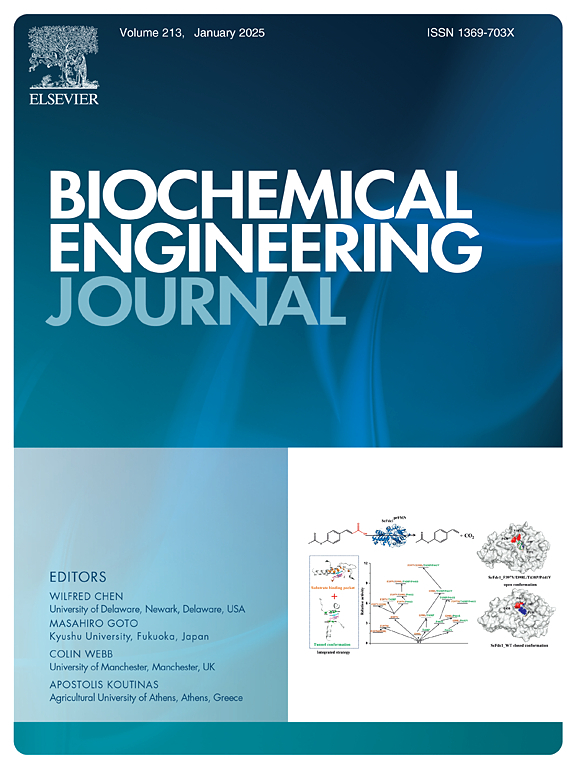Characterization of the dynamic viscosity of cell cultures and its effect on mixing performance in a spinner flask bioreactor
IF 3.7
3区 生物学
Q2 BIOTECHNOLOGY & APPLIED MICROBIOLOGY
引用次数: 0
Abstract
Computational fluid dynamics (CFD) models have been developed to simulate cell culturing bioreactors but assume water-like viscosity properties due to significant data gaps. This study characterized the dynamic viscosity of HEK-293 cell cultures and evaluated its effect on mixing performance in a spinner flask bioreactor. Viscosity measurements indicated that the cell culture media, media with microcarriers, and cell cultures presented shear thinning behaviors within the measured shear rate range of 1 to 100 s-1. The viscosity also increased with the microcarrier concentrations and growth of cell culture. The CFD model, incorporating dynamic viscosity data, showed that shear stress and Kolmogorov length profiles are significantly influenced by microcarrier concentrations and cell culture growth. Higher microcarrier concentrations led to higher average shear stress and Kolmogorov values. The cultured HEK-293 cells after seven days of growth also had higher average shear stress and Kolmogorov values than at the day of seeding, indicating an impact caused by the cells’ metabolism and biomass. Overall, the results indicated that assuming water-like properties underestimates shear stress and Kolmogorov length scales, especially at zones of lower shear rates due to the observed shear thinning behavior. Thus, careful monitoring of dynamic viscosity of cell cultures and proper control of mixing parameters are critical to deliver the desired mixing conditions for optimized cell growth especially during scale-up production operations.
细胞培养物动态粘度的特征及其对旋转瓶生物反应器混合性能的影响
目前已开发出计算流体动力学(CFD)模型来模拟细胞培养生物反应器,但由于数据严重不足,这些模型假定具有类似水的粘度特性。本研究描述了 HEK-293 细胞培养物的动态粘度,并评估了其对旋转瓶生物反应器中混合性能的影响。粘度测量结果表明,细胞培养基、含有微载体的培养基和细胞培养物在 1 到 100 s-1 的测量剪切速率范围内都表现出剪切变稀的行为。粘度还随着微载体浓度和细胞培养物的生长而增加。包含动态粘度数据的 CFD 模型显示,微载体浓度和细胞培养物生长对剪切应力和科尔莫哥罗夫长度曲线有显著影响。微载体浓度越高,平均剪切应力和 Kolmogorov 值越高。生长七天后的 HEK-293 细胞的平均剪切应力和 Kolmogorov 值也高于播种当天,这表明细胞的新陈代谢和生物量造成了影响。总之,研究结果表明,假设细胞具有类似水的特性会低估剪切应力和 Kolmogorov 长度尺度,尤其是在剪切速率较低的区域,这是因为观察到了剪切变稀行为。因此,仔细监测细胞培养物的动态粘度和适当控制混合参数对于提供理想的混合条件以优化细胞生长至关重要,尤其是在放大生产操作过程中。
本文章由计算机程序翻译,如有差异,请以英文原文为准。
求助全文
约1分钟内获得全文
求助全文
来源期刊

Biochemical Engineering Journal
工程技术-工程:化工
CiteScore
7.10
自引率
5.10%
发文量
380
审稿时长
34 days
期刊介绍:
The Biochemical Engineering Journal aims to promote progress in the crucial chemical engineering aspects of the development of biological processes associated with everything from raw materials preparation to product recovery relevant to industries as diverse as medical/healthcare, industrial biotechnology, and environmental biotechnology.
The Journal welcomes full length original research papers, short communications, and review papers* in the following research fields:
Biocatalysis (enzyme or microbial) and biotransformations, including immobilized biocatalyst preparation and kinetics
Biosensors and Biodevices including biofabrication and novel fuel cell development
Bioseparations including scale-up and protein refolding/renaturation
Environmental Bioengineering including bioconversion, bioremediation, and microbial fuel cells
Bioreactor Systems including characterization, optimization and scale-up
Bioresources and Biorefinery Engineering including biomass conversion, biofuels, bioenergy, and optimization
Industrial Biotechnology including specialty chemicals, platform chemicals and neutraceuticals
Biomaterials and Tissue Engineering including bioartificial organs, cell encapsulation, and controlled release
Cell Culture Engineering (plant, animal or insect cells) including viral vectors, monoclonal antibodies, recombinant proteins, vaccines, and secondary metabolites
Cell Therapies and Stem Cells including pluripotent, mesenchymal and hematopoietic stem cells; immunotherapies; tissue-specific differentiation; and cryopreservation
Metabolic Engineering, Systems and Synthetic Biology including OMICS, bioinformatics, in silico biology, and metabolic flux analysis
Protein Engineering including enzyme engineering and directed evolution.
 求助内容:
求助内容: 应助结果提醒方式:
应助结果提醒方式:


